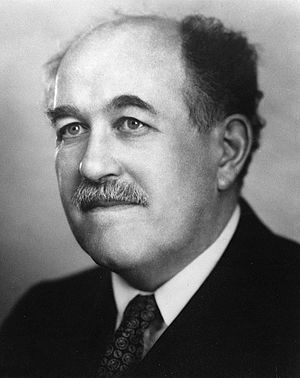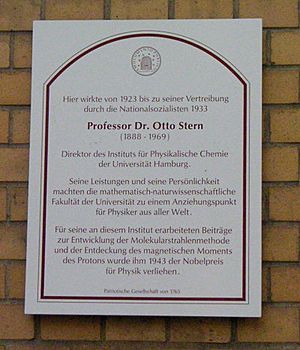Otto Stern facts for kids
Quick facts for kids
Otto Stern
|
|
|---|---|

Stern in 1950s
|
|
| Born | 17 February 1888 |
| Died | 17 August 1969 (aged 81) Berkeley, California, United States
|
| Nationality | Germany, United States |
| Alma mater | University of Breslau University of Frankfurt |
| Known for | Stern–Gerlach experiment Stern model Spin quantization Molecular beam Stern–Volmer relationship |
| Awards | Nobel Prize in Physics (1943) |
| Scientific career | |
| Fields | Physics |
| Institutions | University of Rostock University of Hamburg Carnegie Institute of Technology University of California, Berkeley ETH Zurich |
Otto Stern (German pronunciation: [ˈɔto ˈʃtɛʁn]; 17 February 1888 – 17 August 1969) was a German-American physicist. He won the Nobel Prize in Physics in 1943. He was nominated for the Nobel Prize 82 times between 1925 and 1945. This made him the second most nominated person for the award.
Contents
About Otto Stern
Otto Stern was born into a Jewish family in Sohrau. This town is now called Żory and is in Poland. At the time, it was part of the German Empire. His father, Oskar Stern, owned a mill. His mother was Eugenia Rosenthal. Otto had a brother, Kurt, who became a famous botanist. He also had three sisters.
Stern studied in several cities. These included Freiburg im Breisgau, Munich, and Wrocław.
His Education and Early Career
Stern finished his studies in 1912 at the University of Wrocław. He earned his doctorate in physical chemistry. His research was about how particles move in solutions. After this, he worked with the famous scientist Albert Einstein. They worked together at Charles University in Prague and then at ETH Zurich.
During World War I, Stern worked on weather forecasting. He was on the Russian front. Even then, he continued his studies. In 1915, he earned his Habilitation. This is a special degree that allows you to teach as a professor. He got it from the Goethe University Frankfurt.
In 1921, he became a professor at the University of Rostock. Two years later, in 1923, he moved to the University of Hamburg. There, he became the director of a new institute for physical chemistry.
Moving to America
In 1933, Otto Stern left his job at the University of Hamburg. He resigned because of political changes happening in Germany at that time. He then moved to the United States. He found a new home in Pittsburgh. There, he became a physics professor at the Carnegie Institute of Technology. During the 1930s, he also taught as a visiting professor at the University of California, Berkeley.
Key Discoveries and Nobel Prize
Otto Stern was an experimental physicist. This means he did experiments to learn about the world. He made many important discoveries:
- Spin Quantization: In 1922, he worked with Walther Gerlach. They did the Stern–Gerlach experiment. This experiment showed that tiny particles, like electrons, have a property called "spin." Imagine them spinning like tiny tops.
- Wave Nature of Atoms: He showed that atoms and molecules can act like waves.
- Atomic Magnetic Moments: He measured the magnetic properties of atoms.
- Proton's Magnetic Moment: He discovered that protons also have a magnetic property.
- Molecular Beam Method: He developed a special way to study atoms and molecules. This method uses a "molecular beam." It helps scientists study how these tiny particles behave.
Nobel Prize in Physics
Otto Stern was awarded the 1943 Nobel Prize in Physics. This was the first Nobel Prize given out since 1939. He won the prize alone. The award was "for his contribution to the development of the molecular ray method and his discovery of the magnetic moment of the proton." The 1943 prize was actually given to him in 1944.
Later Life and Legacy
After retiring from the Carnegie Institute of Technology, Otto Stern moved to Berkeley, California. He often visited physics talks at the University of California, Berkeley. He passed away from a heart attack in Berkeley on 17 August 1969.
A special award for excellent experimental physics is named after him and Walther Gerlach. It is called the Stern-Gerlach-Medaille. His niece, Lieselotte Templeton, became a crystallographer.
See also
 In Spanish: Otto Stern para niños
In Spanish: Otto Stern para niños
- List of German inventors and discoverers


